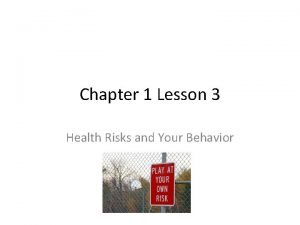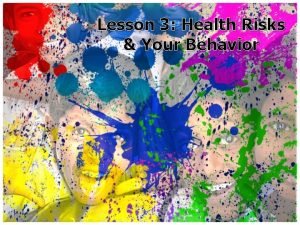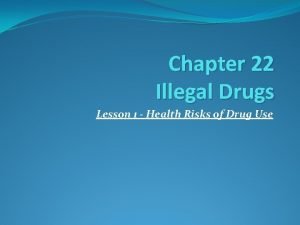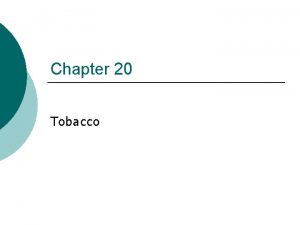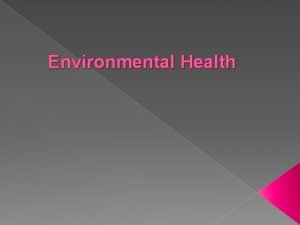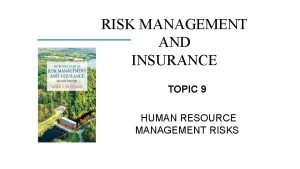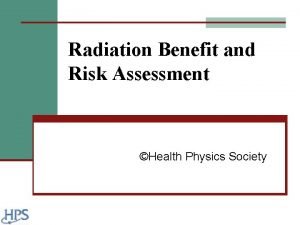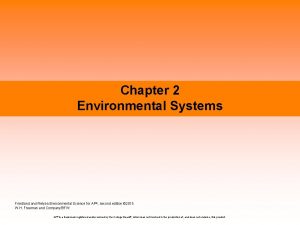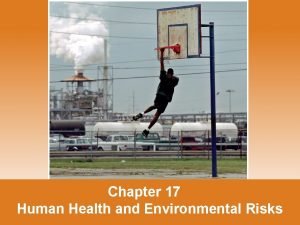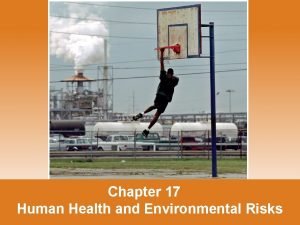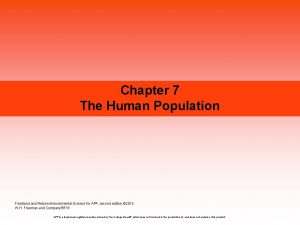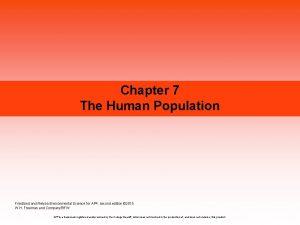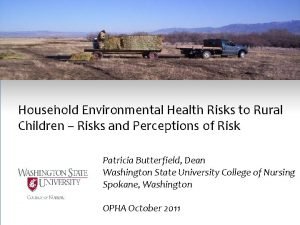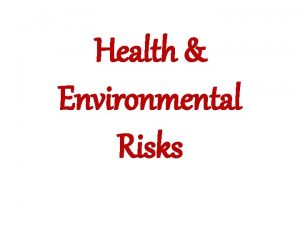Chapter 17 Human Health and Environmental Risks Friedland














- Slides: 14

Chapter 17 Human Health and Environmental Risks Friedland Relyea Environmental Science for AP ®, second edition © 2015 W. H. Freeman and Company/BFW AP® is a trademark registered and/or owned by the College Board ®, which was not involved in the production of, and does not endorse, this product.

Module 56 Human Disease After reading this module you should be able to • Identify the different types of human diseases. • Understand the risk factors for human chronic diseases. • Discuss the historically important human diseases. • Identify the major emergent infectious diseases. • Discuss the future challenges for improving human health.

There are different types of human diseases • Disease Any impaired function of the body with a characteristic set of symptoms. • Infectious disease A disease caused by a pathogen. • Acute disease A disease that rapidly impairs the functioning of an organism. • Chronic disease A disease that slowly impairs the functioning of an organism.

Types of Human Diseases Leading causes of death in the world. (a) More than three-quarters of all world deaths are caused by diseases, including respiratory and digestive diseases, various cancers, cardiovascular diseases, and infectious diseases. (b) Among the world’s deaths caused by infectious diseases, 94 percent are caused by only six types of diseases.

Numerous risk factors exist for chronic risk factors in humans • In low-income countries, the top risk factors leading to chronic disease are associated with poverty, including unsafe drinking water, poor sanitation, and malnutrition. • Risk factors for chronic disease in high-income countries include increased availability of tobacco, and a combination of less active lifestyles, poor nutrition, and overeating that leads to high blood pressure and obesity.

Chronic Risk Factors in Humans Leading health risks in the world. If we consider all deaths that occur and separate them into different causes, we can examine which categories cause the highest percentage of all deaths. The leading health risks for low-income countries include issues related to low nutrition and poor sanitation. The leading risks for high-income countries include issues related to tobacco use, inactivity, obesity, and urban air pollution.

Some infectious diseases have been historically important • Environmental scientists are interested in diseases that have environmental causes, especially those caused by pathogens such as fungi, bacteria, and viruses. Pathways of transmitting pathogens. Pathogens have evolved a wide variety of ways to infect humans.

Infectious Disease • Epidemic A situation in which a pathogen causes a rapid increase in disease. • Pandemic An epidemic that occurs over a large geographic region. • Plague An infectious disease caused by a bacterium (Yersinia pestis) that is carried by fleas. • Malaria An infectious disease caused by one of several species of protists in the genus Plasmodium. • Tuberculosis A highly contagious disease caused by the bacterium Mycobacterium tuberculosis that primarily infects the lungs.

Tuberculosis cases and deaths. (a) Due to effective and available medicines, tuberculosis has gone from being one of the most deadly diseases in the United States to a disease that rarely kills. (b) Worldwide, however, tuberculosis has continued to infect and kill millions of people, especially in low- and middle-income countries.

Emergent infectious diseases pose new risks to humans • Emergent infectious disease An infectious disease that has not been previously described or has not been common for at least 20 years. The emergence of new diseases. Since the 1970 s, new diseases, or diseases that have been rare for more than 20 years, have been appearing throughout the world at a rate of approximately one per year.

Emergent Infectious Diseases • Human Immunodeficiency Virus (HIV) A type of virus that causes Acquired Immune Deficiency Syndrome (AIDS). • Ebola hemorrhagic fever An infectious disease with high death rates, caused by the Ebola virus.

Emergent Infectious Diseases • Mad cow disease A disease in which prions mutate into deadly pathogens and slowly damage a cow’s nervous system. Why is the Cow so Mad? • Prion A small, beneficial protein that occasionally mutates into a pathogen. • Swine flu A type of flu caused by the H 1 N 1 virus. How Flu Viruses Attack • Bird flu A type of flu caused by the H 5 N 1 virus.

Emergent Infectious Diseases • Severe acute respiratory syndrome (SARS) A type of flu caused by a coronavirus. • West Nile virus A virus that lives in hundreds of species of birds and is transmitted among birds by mosquitoes.

Human health faces a number of future challenges • Low-income countries need improvements in nutrition, wider availability of clean drinking water, and proper sanitation. • High-income countries need to promote healthier lifestyle choices such as increased physical activity, a balanced diet, and limiting excess food consumption and tobacco use. • Education is needed everywhere to reduce the spread of diseases such as HIV and tuberculosis. • The Global Fight Against Malaria
 Friedland and relyea environmental science
Friedland and relyea environmental science Psoas major synergist
Psoas major synergist Medienkonzepte friedland
Medienkonzepte friedland Chapter 1 lesson 3 health risks and your behavior
Chapter 1 lesson 3 health risks and your behavior Chapter 1 lesson 3 health risks and your behavior
Chapter 1 lesson 3 health risks and your behavior Chapter 1 lesson 3 health risks and your behavior
Chapter 1 lesson 3 health risks and your behavior Chapter 22 illegal drugs
Chapter 22 illegal drugs Chapter 20 lesson 1
Chapter 20 lesson 1 Chapter 20 tobacco vocabulary practice
Chapter 20 tobacco vocabulary practice Define enviromental health
Define enviromental health Human resource risks examples
Human resource risks examples Health risks
Health risks Lifewave antenna
Lifewave antenna Mh 605
Mh 605 Media and information opportunities challenges
Media and information opportunities challenges




